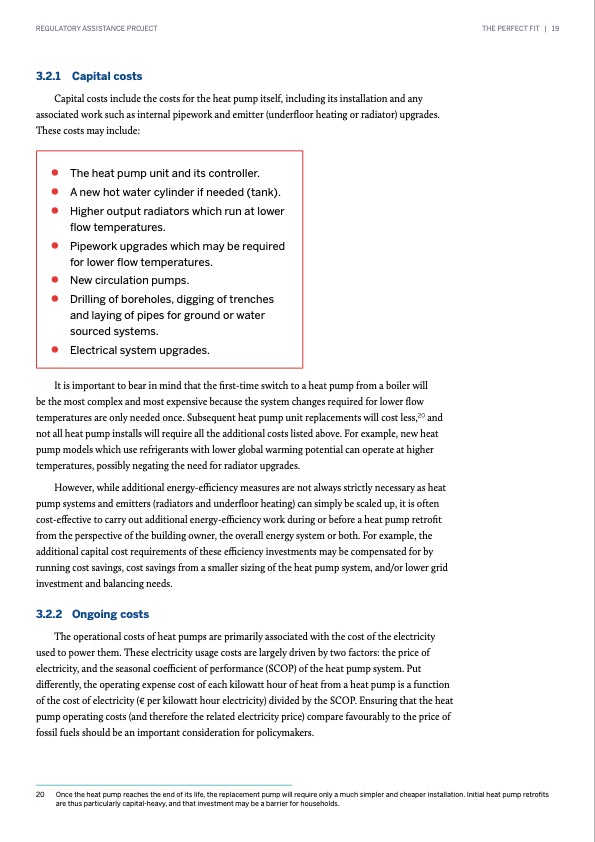
PDF Publication Title:
Text from PDF Page: 019
REGULATORY ASSISTANCE PROJECT THE PERFECT FIT | 19 3.2.1 Capital costs Capital costs include the costs for the heat pump itself, including its installation and any associated work such as internal pipework and emitter (underfloor heating or radiator) upgrades. These costs may include: • The heat pump unit and its controller. • A new hot water cylinder if needed (tank). • Higher output radiators which run at lower flow temperatures. • Pipework upgrades which may be required for lower flow temperatures. • New circulation pumps. • Drilling of boreholes, digging of trenches and laying of pipes for ground or water sourced systems. • Electrical system upgrades. It is important to bear in mind that the first-time switch to a heat pump from a boiler will be the most complex and most expensive because the system changes required for lower flow temperatures are only needed once. Subsequent heat pump unit replacements will cost less,20 and not all heat pump installs will require all the additional costs listed above. For example, new heat pump models which use refrigerants with lower global warming potential can operate at higher temperatures, possibly negating the need for radiator upgrades. However, while additional energy-efficiency measures are not always strictly necessary as heat pump systems and emitters (radiators and underfloor heating) can simply be scaled up, it is often cost-effective to carry out additional energy-efficiency work during or before a heat pump retrofit from the perspective of the building owner, the overall energy system or both. For example, the additional capital cost requirements of these efficiency investments may be compensated for by running cost savings, cost savings from a smaller sizing of the heat pump system, and/or lower grid investment and balancing needs. 3.2.2 Ongoing costs The operational costs of heat pumps are primarily associated with the cost of the electricity used to power them. These electricity usage costs are largely driven by two factors: the price of electricity, and the seasonal coefficient of performance (SCOP) of the heat pump system. Put differently, the operating expense cost of each kilowatt hour of heat from a heat pump is a function of the cost of electricity (€ per kilowatt hour electricity) divided by the SCOP. Ensuring that the heat pump operating costs (and therefore the related electricity price) compare favourably to the price of fossil fuels should be an important consideration for policymakers. 20 Once the heat pump reaches the end of its life, the replacement pump will require only a much simpler and cheaper installation. Initial heat pump retrofits are thus particularly capital-heavy, and that investment may be a barrier for households.PDF Image | RAP Perfect Fit Heat Pump

PDF Search Title:
RAP Perfect Fit Heat PumpOriginal File Name Searched:
RAP-heat-pump-report-FINAL_2022_03.pdfDIY PDF Search: Google It | Yahoo | Bing
CO2 Organic Rankine Cycle Experimenter Platform The supercritical CO2 phase change system is both a heat pump and organic rankine cycle which can be used for those purposes and as a supercritical extractor for advanced subcritical and supercritical extraction technology. Uses include producing nanoparticles, precious metal CO2 extraction, lithium battery recycling, and other applications... More Info
Heat Pumps CO2 ORC Heat Pump System Platform More Info
| CONTACT TEL: 608-238-6001 Email: greg@infinityturbine.com | RSS | AMP |